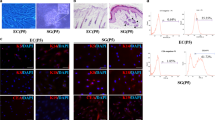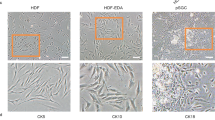Abstract
Human umbilical cord-derived mesenchymal stem cells (hUC-MSCs) possess various advantageous properties, including self-renewal, extended proliferation potential, multi-lineage differentiation potential and capacity for differentiating into sweat gland-like cells in certain conditions. However, little is known about the effect of clinical-grade culture conditions on these properties and on the differentiative potential of hUC-MSCs. In this study, we sought to investigate the properties of hUC-MSCs expanded with animal serum free culture media (ASFCM) in order to determine their potential for differentiation into sweat gland-like cells. We found that primary cultures of hUC-MSCs could be established with ASFCM. Moreover, cells cultured in ASFCM showed vigorous proliferation comparable to those of cells grown in classical culture conditions containing fetal bovine serum (FBS). Morphology of hUC-MSCs cultured in ASFCM was comparable to those of cells grown under classical culture conditions, and hUC-MSCs grown in both of the two culture conditions tested showed the typical antigen profile of MSCs—positive for CD29, CD44, CD90, and CD105, and negative for CD34 and CD45, as expected. Chromosomal aberration assay revealed that the cells were stable after long-term culture under both culture conditions. Like normal cultured MSCs, hUC-MSCs induced under ASFCM conditions exhibited expression of the same markers (CEA, CK14 and CK19) and developmental genes (EDA and EDAR) that are characteristic of normal sweat gland cells. Taken together, our findings indicate that the classical culture medium used to differentiate hUC-MSCs into sweat gland-like cells can be replaced safely by ASFCM for clinical purposes.
Similar content being viewed by others
References
Yang S, Huang S, Feng C, Fu X. Umbilical cord-derived mesenchymal stem cells: strategies, challenges, and potential for cutaneous regeneration. Front Med 2012; 6(1): 41–47
Lu LL, Liu YJ, Yang SG, Zhao QJ, Wang X, Gong W, Han ZB, Xu ZS, Lu YX, Liu D, Chen ZZ, Han ZC. Isolation and characterization of human umbilical cord mesenchymal stem cells with hematopoiesis-supportive function and other potentials. Haematologica 2006; 91(8): 1017–1026
Kim JW, Kim SY, Park SY, Kim YM, Kim JM, Lee MH, Ryu HM. Mesenchymal progenitor cells in the human umbilical cord. Ann Hematol 2004; 83(12): 733–738
Wang HS, Hung SC, Peng ST, Huang CC, Wei HM, Guo YJ, Fu YS, Lai MC, Chen CC. Mesenchymal stem cells in the Wharton’s jelly of the human umbilical cord. Stem Cells 2004; 22(7): 1330–1337
Friedenstein AJ, Gorskaja JF, Kulagina NN. Fibroblast precursors in normal and irradiated mouse hematopoietic organs. Exp Hematol 1976; 4(5): 267–274
Pittenger MF, Mackay AM, Beck SC, Jaiswal RK, Douglas R, Mosca JD, Moorman MA, Simonetti DW, Craig S, Marshak DR. Multilineage potential of adult human mesenchymal stem cells. Science 1999; 284(5411): 143–147
Lennon DP, Edmison JM, Caplan AI. Cultivation of rat marrowderived mesenchymal stem cells in reduced oxygen tension: effects on in vitro and in vivo osteochondrogenesis. J Cell Physiol 2001; 187(3): 345–355
Sekiya I, Vuoristo JT, Larson BL, Prockop DJ. In vitro cartilage formation by human adult stem cells from bone marrow stroma defines the sequence of cellular and molecular events during chondrogenesis. Proc Natl Acad Sci USA 2002; 99(7): 4397–4402
Fu YS, Cheng YC, Lin MY, Cheng H, Chu PM, Chou SC, Shih YH, Ko MH, Sung MS. Conversion of human umbilical cord mesenchymal stem cells in Wharton’s jelly to dopaminergic neurons in vitro: potential therapeutic application for Parkinsonism. Stem Cells 2006; 24(1): 115–124
Wu KH, Zhou B, Lu SH, Feng B, Yang SG, Du WT, Gu DS, Han ZC, Liu YL. In vitro and in vivo differentiation of human umbilical cord derived stem cells into endothelial cells. J Cell Biochem 2007; 100(3): 608–616
Weiss ML, Anderson C, Medicetty S, Seshareddy KB, Weiss RJ, VanderWerff I, Troyer D, McIntosh KR. Immune properties of human umbilical cord Wharton’s jelly-derived cells. Stem Cells 2008; 26(11): 2865–2874
Sheng ZY, Fu XB, Cai S, Lei YH, Sun TZ, Bai XD, Chen ML. Functional sweat gland implantation: a report of two cases. Med J Chin PLA (Jie Fang Jun Yi Xue Za Zhi). 2008; 33(4): 363–368 (in Chinese)
Sheng Z, Fu X, Cai S, Lei Y, Sun T, Bai X, Chen M. Regeneration of functional sweat gland-like structures by transplanted differentiated bone marrow mesenchymal stem cells. Wound Repair Regen 2009; 17(3): 427–435
Xu Y, Huang S, Ma K, Fu X, Han W, Sheng Z. Promising new potential for mesenchymal stem cells derived from human umbilical cord Wharton’s jelly: sweat gland cell-like differentiative capacity. J Tissue Eng Regen Med 2012; 6(8): 645–654
Huang P, Lin LM, Wu XY, Tang QL, Feng XY, Lin GY, Lin X, Wang HW, Huang TH, Ma L. Differentiation of human umbilical cord Wharton’s jelly-derived mesenchymal stem cells into germlike cells in vitro. J Cell Biochem 2010; 109(4): 747–754
Mikkola ML. TNF superfamily in skin appendage development. Cytokine Growth Factor Rev 2008; 19(3–4): 219–230
Rao MS, Mattson MP. Stem cells and aging: expanding the possibilities. Mech Ageing Dev 2001; 122(7): 713–734
Saga K. Structure and function of human sweat glands studied with histochemistry and cytochemistry. Prog Histochem Cytochem 2002; 37(4): 323–386
Biedermann T, Pontiggia L, Böttcher-Haberzeth S, Tharakan S, Braziulis E, Schiestl C, Meuli M, Reichmann E. Human eccrine sweat gland cells can reconstitute a stratified epidermis. J Invest Dermatol 2010; 130(8): 1996–2009
Ball LM, Bernardo ME, Roelofs H, Lankester A, Cometa A, Egeler RM, Locatelli F, Fibbe WE. Cotransplantation of ex vivo expanded mesenchymal stem cells accelerates lymphocyte recovery and may reduce the risk of graft failure in haploidentical hematopoietic stemcell transplantation. Blood 2007; 110(7): 2764–2767
Le Blanc K, Frassoni F, Ball L, Locatelli F, Roelofs H, Lewis I, Lanino E, Sundberg B, Bernardo ME, Remberger M, Dini G, Egeler RM, Bacigalupo A, Fibbe W, Ringdén O; Developmental Committee of the European Group for Blood and Marrow Transplantation. Mesenchymal stem cells for treatment of steroidresistant, severe, acute graft-versus-host disease: a phase II study. Lancet 2008; 371(9624): 1579–1586
Christopeit M, Schendel M, Föll J, Müller LP, Keysser G, Behre G. Marked improvement of severe progressive systemic sclerosis after transplantation of mesenchymal stem cells from an allogeneic haploidentical-related donor mediated by ligation of CD137L. Leukemia 2008; 22(5): 1062–1064
Cui CY, Schlessinger D. EDA signaling and skin appendage development. Cell Cycle 2006; 5(21): 2477–2483
Author information
Authors and Affiliations
Corresponding authors
Additional information
These authors contributed equally to this work
Electronic supplementary material
Rights and permissions
About this article
Cite this article
Yang, S., Ma, K., Feng, C. et al. Capacity of human umbilical cord-derived mesenchymal stem cells to differentiate into sweat gland-like cells: a preclinical study. Front. Med. 7, 345–353 (2013). https://doi.org/10.1007/s11684-013-0282-2
Received:
Accepted:
Published:
Issue Date:
DOI: https://doi.org/10.1007/s11684-013-0282-2




